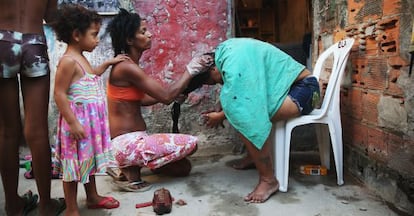Extreme poverty rises in Brazil for first time in a decade
Statistics institute reported to have posted figures after election to avoid harming Rousseff


The number of Brazilians living in extreme poverty has grown for the first time in 10 years, rising from 10.08 million citizens in 2012 to 10.45 million last year.
The figures were released on October 30 by the Institute for Applied Economic Research (Ipea), which simply posted them on its website and failed to call a press conference to inform the media.
The numbers contradict the message sent out during the recent election campaign by the victorious Workers’ Party, and particularly by re-elected President Dilma Rousseff and her predecessor Luiz Inácio Lula da Silva, both of whom claimed that poverty reduction would come under threat if Brazilians voted for a new leader.
This is the first time that the number of Brazilians living in extreme poverty has stopped declining since 2003. By Ipea’s count, people in extreme poverty are those who cannot afford the monthly cost of a basic food basket, whose price ranges from $26.90 in Belém, capital of Pará state, to $50 in Porto Alegre, capital of Rio Grande do Sul.
Renato Meirelles, president of Data Popular, an agency specializing in information about the poorest segments of the population, believes that these results create a new challenge for the government: finding the people who are still not signed up to Bolsa Familia, the government’s main social welfare program.
“There’s the economic issue, which has a direct impact on extreme poverty,” says Meirelles. “But all public policies need to reach the places they haven’t yet reached.
“Brazil has one of the best social protection systems in the world, and these 10 million people should not be living in extreme poverty. They need to be protected by the programs,” he adds.
If this network of social welfare does not expand, there is a risk that extreme poverty will keep growing next year, explains Meirelles. “Leaders should glean lessons from the election results: it is necessary to radicalize economic development and the income distribution programs that have advanced the country in recent decades.”
Although the number of people in extreme poverty has increased slightly, the poor population keeps declining
Although the number of people in extreme poverty has increased slightly, Brazil’s poor population – those with twice the family income as those in indigence – keeps dropping: from 30.3 million in 2012 to 26.6 million last year. A decade ago, 60.1 million Brazilians were living in poverty.
The figures were released on Wednesday by the daily Folha de São Paulo following a controversy that took place during the election campaign. In mid-October, Herton Araújo, director of the Social Studies and Policies department at Ipea, quit his job after the institute decided to withhold the extreme poverty figures until after the elections.
Doing so could have helped the opposition, led by Social Democrat Aécio Neves, who lost to Rousseff by a narrow margin in the October 26 run-off.
An Ipea press department release claimed that “nobody was available to discuss the issue” and that in any case the media “were never informed about our database updates.”
Tu suscripción se está usando en otro dispositivo
¿Quieres añadir otro usuario a tu suscripción?
Si continúas leyendo en este dispositivo, no se podrá leer en el otro.
FlechaTu suscripción se está usando en otro dispositivo y solo puedes acceder a EL PAÍS desde un dispositivo a la vez.
Si quieres compartir tu cuenta, cambia tu suscripción a la modalidad Premium, así podrás añadir otro usuario. Cada uno accederá con su propia cuenta de email, lo que os permitirá personalizar vuestra experiencia en EL PAÍS.
En el caso de no saber quién está usando tu cuenta, te recomendamos cambiar tu contraseña aquí.
Si decides continuar compartiendo tu cuenta, este mensaje se mostrará en tu dispositivo y en el de la otra persona que está usando tu cuenta de forma indefinida, afectando a tu experiencia de lectura. Puedes consultar aquí los términos y condiciones de la suscripción digital.








































